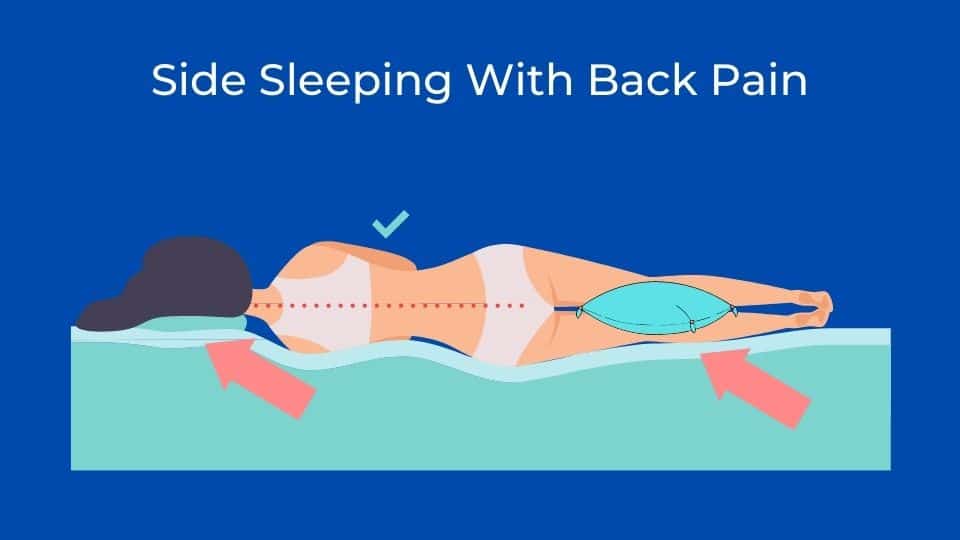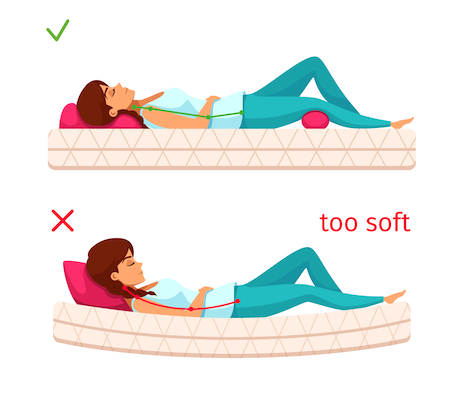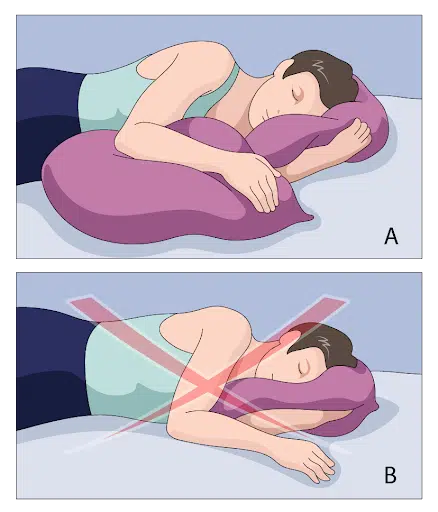Which Sleeping Posture Is Right to Reduce Your Type of Back Pain?

Understanding Back Pain and Sleep
Back pain is a pervasive issue that affects millions of people worldwide. It can significantly impact various aspects of life, including sleep quality. Poor sleep exacerbates back pain, creating a vicious cycle of discomfort and restlessness. Understanding the relationship between back pain and sleep is crucial for finding relief and improving overall well-being.
The right sleeping posture can alleviate back pain and enhance sleep quality. However, the best position may vary depending on the type of back pain you experience. By tailoring your sleeping posture to your specific needs, you can reduce discomfort and enjoy more restful nights. This article will explore the best sleeping positions for different types of back pain and provide additional tips for improving sleep quality.
Types of Back Pain
Back pain can be categorized into several types, each with its own causes and characteristics. Understanding the type of back pain you have can help you choose the most effective sleeping posture.

Lower Back Pain
Lower back pain is one of the most common types of back pain. It can result from various factors, including muscle strain, poor posture, herniated discs, or degenerative conditions like arthritis. Lower back pain can be acute or chronic and may vary in intensity.
Upper Back Pain
Upper back pain, although less common than lower back pain, can be equally debilitating. It often stems from poor posture, muscle strain, or injuries. Upper back pain can also be related to issues with the neck or shoulders.
Shoulder Pain
Shoulder pain is a frequent companion of upper back pain. It can arise from various sources, including rotator cuff injuries, bursitis, or tendinitis. Shoulder pain can make finding a comfortable sleeping position challenging.
Neck Pain
Neck pain is a common complaint that can interfere with sleep. It often results from poor sleeping posture, inadequate pillow support, or muscle strain. Neck pain can radiate to the shoulders and upper back, further complicating sleep.
Sciatic Pain
Sciatic pain, or sciatica, is characterized by pain that radiates from the lower back down the legs. It is caused by compression or irritation of the sciatic nerve. Sciatic pain can be sharp, shooting, or burning and may worsen with certain sleeping positions.
Importance of Choosing the Right Sleeping Posture
Choosing the right sleeping posture is essential for managing back pain. The correct position can help maintain the natural curves of your spine, reduce pressure on sensitive areas, and promote muscle relaxation. Conversely, poor sleeping posture can exacerbate back pain, leading to restless nights and prolonged discomfort.
In addition to the right sleeping posture, other factors, such as mattress quality, pillow support, and sleep environment, play crucial roles in alleviating back pain and improving sleep. This article will delve into each of these aspects to provide comprehensive guidance for a pain-free and restful sleep.
Sleeping Posture for Lower Back Pain
Lower back pain can be particularly debilitating, making it difficult to find a comfortable sleeping position. However, certain postures can provide significant relief and promote better sleep.
Sleeping on Your Back with Knee Support

One of the best sleeping positions for lower back pain is lying on your back with a pillow under your knees. This position helps maintain the natural curve of your spine by reducing pressure on your lower back. The pillow under your knees keeps your spine in a neutral position, preventing excessive arching or flattening of the lower back.
To further enhance comfort, you can place a small rolled towel under the small of your back for additional support. This extra support can help alleviate pressure on the lower back muscles and discs.
Sleeping on Your Side with a Pillow Between Your Knees
Another effective position for lower back pain is sleeping on your side with a pillow between your knees. This posture helps keep your spine aligned and reduces strain on your lower back. The pillow between your knees prevents your top leg from pulling your spine out of alignment, which can alleviate pressure on your lower back.
Ensure that your head and neck are also supported with a suitable pillow to maintain proper alignment throughout your spine. Avoid curling up too tightly, as this can strain your back and hips.
Ideal Position for Upper Back Pain
Upper back pain can be caused by poor posture, muscle strain, or injuries. Finding the right sleeping position is crucial for relieving upper back pain and ensuring restful sleep.

Sleeping on Your Back with Head and Neck Support
Sleeping on your back is often recommended for upper back pain. This position allows your head, neck, and spine to align naturally, reducing strain on your upper back muscles. Use a supportive pillow that keeps your head and neck in a neutral position. The pillow should not be too high or too flat, as improper support can lead to additional strain on your upper back.
Additionally, consider placing a small pillow or rolled towel under your upper back for extra support. This can help maintain the natural curve of your upper spine and alleviate pressure on your muscles.
Sleeping on Your Side with Proper Alignment
Sleeping on your side can also be beneficial for upper back pain, provided you maintain proper alignment. Use a pillow that supports your head and neck, keeping them aligned with your spine. Placing a pillow between your knees can help maintain spinal alignment and reduce strain on your upper back.
Avoid sleeping on your stomach, as this position can strain your neck and upper back, leading to increased pain and discomfort.
Best Sleeping Posture for Shoulder Pain
Shoulder pain can make it challenging to find a comfortable sleeping position. However, certain postures can help alleviate shoulder pain and promote better sleep.

Avoid Sleeping on the Affected Shoulder
If you have shoulder pain, it's essential to avoid sleeping on the affected side. This can exacerbate the pain and lead to further discomfort. Instead, sleep on your back or the opposite side.
Sleeping on Your Back with Pillow Support
Sleeping on your back is a recommended position for shoulder pain. Use a supportive pillow under your head to keep your neck and spine aligned. Additionally, consider placing a pillow under your arm on the affected side to reduce strain on your shoulder. This can help alleviate pressure and promote a more comfortable sleep.
Sleeping on Your Side with Pillow Between Arms
If you prefer sleeping on your side, ensure that you do not lie on the affected shoulder. Use a supportive pillow for your head and neck, and place a pillow between your arms to keep your shoulders aligned. This can help reduce strain on your shoulder and alleviate pain.
Sleeping Position for Neck Pain
Neck pain can significantly impact your sleep quality. Finding the right sleeping position is crucial for relieving neck pain and ensuring restful sleep.

Sleeping on Your Back with Proper Pillow Support
Sleeping on your back is often recommended for neck pain. Use a pillow that supports the natural curve of your neck. Memory foam or cervical pillows can provide excellent support by conforming to the shape of your head and neck. Ensure that your pillow is not too high or too flat, as improper support can lead to additional strain on your neck.
Sleeping on Your Side with Head and Neck Alignment
If you prefer sleeping on your side, use a pillow that keeps your head and neck aligned with your spine. The pillow should fill the space between your neck and the mattress to maintain proper alignment. Placing a pillow between your knees can also help keep your spine aligned and reduce strain on your neck.
Alleviating Sciatic Pain with the Right Sleeping Posture
Sciatic pain can be particularly challenging to manage during sleep. However, certain sleeping positions can help alleviate discomfort and promote better rest.
Sleeping on Your Back with Elevated Knees
Sleeping on your back with your knees elevated can help alleviate sciatic pain. Place a pillow or wedge under your knees to keep them slightly bent. This position reduces pressure on the sciatic nerve and helps maintain the natural curve of your spine.
Sleeping on Your Side with a Pillow Between Your Knees
Sleeping on your side with a pillow between your knees can also provide relief for sciatic pain. This position keeps your spine aligned and reduces pressure on the sciatic nerve. Ensure that your head and neck are properly supported with a suitable pillow to maintain alignment throughout your spine.
Additional Tips for Improving Sleep Quality
In addition to choosing the right sleeping posture, several other factors can influence your sleep quality. Here are some tips to help you improve your sleep and alleviate back pain:
Invest in a Supportive Mattress and Pillows
A supportive mattress is essential for maintaining proper spinal alignment and reducing back pain. Choose a mattress that provides adequate support for your body type and sleeping position. Additionally, use pillows that support your head, neck, and spine. Memory foam or orthopedic pillows can offer customized support and enhance comfort.
Establish a Consistent Sleep Routine
Maintaining a consistent sleep schedule can improve your sleep quality and help reduce back pain. Go to bed and wake up at the same time every day, even on weekends. This consistency helps regulate your body's internal clock and promotes a healthy sleep routine.
Create a Comfortable Sleep Environment
Ensure your bedroom is conducive to sleep by keeping it dark, quiet, and cool. Use blackout curtains to block out light, and consider using a white noise machine or earplugs to minimize noise disturbances. Maintaining a comfortable temperature can also promote better sleep.
Practice Good Sleep Hygiene
Good sleep hygiene involves habits and practices that promote better sleep. This includes avoiding caffeine and heavy meals before bedtime, limiting screen time, and engaging in relaxing activities, such as reading or taking a warm bath, to wind down before bed.
Stay Active During the Day
Regular physical activity can improve sleep quality and reduce back pain. Engaging in exercises that strengthen your core and back muscles can provide additional support for your spine and alleviate discomfort. However, avoid vigorous exercise close to bedtime, as it can interfere with your ability to fall asleep.
Manage Stress and Anxiety
Stress and anxiety can significantly impact sleep quality. Practice relaxation techniques, such as deep breathing, meditation, or yoga, to manage stress and promote relaxation. Creating a calming bedtime routine can also help reduce anxiety and prepare your mind for sleep.
Conclusion
Finding the right sleeping posture is essential for reducing back pain and improving sleep quality. By adjusting your sleeping position according to your specific type of back pain, you can alleviate discomfort and enjoy more restful nights. Remember, a supportive mattress and pillows, along with a consistent sleep routine and a comfortable sleep environment, can significantly impact your comfort and well-being.
Experiment with different sleeping positions and make adjustments as needed to find what works best for you. If back pain persists despite trying various sleeping postures and improving sleep hygiene, consider consulting a healthcare professional for further evaluation and treatment. By taking proactive steps to address back pain and prioritize sleep, you can enhance your overall quality of life and achieve better rest.
